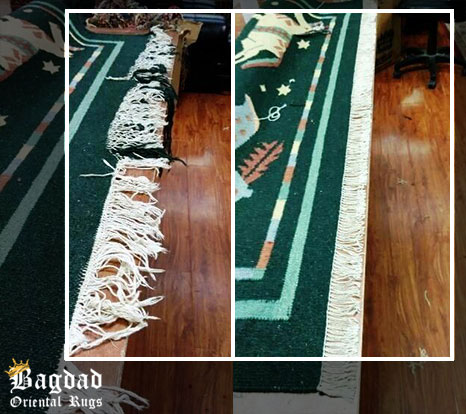When quick, decisive action is needed to protect and preserve your rug, the solution is simple: rug restoration! Many reputable rug restoration shops in Houston , such as Bagdad Oriental Rugs, offer a full range of professional services designed to return your area rug to its former glory. To determine whether your area rug is a candidate for restoration, we have compiled rug restoration specialist tips that we believe can help.
How does rug restoration differ from rug repair?
People often confuse rug repair with rug restoration and we’d like to correct this misconception. The difference between the two is that a repair fixes a specific problem, such as a rip or tear, while a restoration returns the piece to its original condition. While some rug restorations can be considered repairs, not all repair jobs are restorations since they focus on a particular issue and don’t seek to bring the rug to a like-new state. Therefore, rug repair can best be thought of as a step of rug restoration, which deals not only with rips and tears but also other concerns like fringe unraveling or color bleeding and fading.

What rug restoration services are provided by rug specialists?
Expert rug restoration specialists are able to work with a variety of rug types, including rugs made from natural materials such as wool and silk, as well as those made from synthetic materials such as polypropylene, animal hides, synthetic material, viscose, and jute. They’re also able to restore rugs regardless of whether they were hand knotted, hand tufted or machine-made, and can reverse damage caused by mold, water and even fire.
Rug restoration experts take a comprehensive approach in which they identify which parts need fixing and work to restore interconnected aspects of the rug. Here are some of the individual aspects of rug restoration:
- Fringe repairing: This mainly involves replacing rug fringes that have become worn out and damaged due to age or by having them pulled at. Another aspect of fringe work is fringe removal, which entails either removing them entirely or trimming ones that have gotten too long and raggedy.
- Binding: Repairing a rug’s binding helps to ensure that the piece doesn’t fall apart. The process entails carefully repairing worn edges by hand and making sure to carefully match the rebinded portions to the original rug color.
- Reweaving: If there are holes and rips in a rug, reweaving (or patching) the worn-out area can do the trick. This technique is especially useful when restoring high pile rugs whose stitching has come loose due to natural wear and tear.
- Re-dyeing: As the name implies, re-dyeing is the art of restoring colors to rugs that faded or bled due to damage resulting from sun overexposure, liquid staining or other causes.
Rug restoration specialists are equipped to handle all types of specialty repairs in addition to the ones mentioned above. In order to know whether professional rug repair and restoration work needs to be performed, you are advised to bring your rug into a reputable rug store for a detailed inspection.
Should this rug be professionally restored?
Most rug restorations can be achieved when you take it in for an in-store rug repair visit. However, for certain specialty woven rugs, the answer can be a bit trickier. The reason for this is that woven wool rugs are practically indestructible, whereas tufted rugs (or at least the cheaply made ones) have significant shorter lifespans. This doesn’t mean that woven rugs shouldn’t be taken in for periodic restorations, however.
If you have a wool, silk or cotton rug, you may want to consider specialty rug restorations. Should you have any questions about the need for a rug restoration, consult with one of our specialists today!

